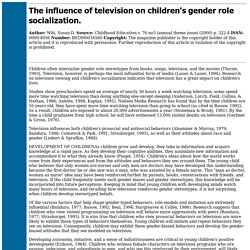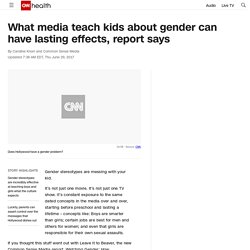

What is Observational Learning? Bandura's Observational Learning Explained! What is Observational Learning? - Water Bear Learning. Canadian/American psychologist, Albert Bandura, was one of the first psychologists to recognize the phenomenon of observational learning.

His theory, Social Learning Theory, stresses the importance of observation and modeling of behaviors, attitudes and emotional reactions of others. He found that, as social animals, humans naturally gravitate toward observational learning. Children watch their family members and mimic their behaviors. Even infants, at just 3-weeks old, start imitating mouth movements and facial expressions of adults around them.
Learning Gender Roles through Observation of Peers. Learning Gender Roles through Observation of the Society. What is the Influence of Media? How Media Affects Gender Role Development. How Stereotypes in Movies and on TV Impact Kids' Development [downloadable] - CHC Resource Library. A new Common Sense Media study shows that learning gender roles from movies and TV shows has real consequences on kids’ self-esteem, relationships, and even their future careers.
![How Stereotypes in Movies and on TV Impact Kids' Development [downloadable] - CHC Resource Library](http://cdn.pearltrees.com/s/pic/th/stereotypes-downloadable-254147021)
The Common Sense Media report, Watching Gender: How Stereotypes in Movies and on TV Impact Kids’ Development analyzes more than 150 articles, interviews, books, and other social-scientific research and finds that gender stereotypes in movies and on TV shows are widespread and very influential — teaching children what the culture expects of boys and girls. According to the report, a lifetime of viewing stereotypical media becomes so ingrained it can ultimately affect kids’ career choices, self-worth, relationships, and ability to achieve their full potential. Key Findings: Download the 19-page report to learn more about this research, and read this Common Sense Media blog post for recommendations on actions parents can take to counteract gender stereotypes.
Do you have concerns about your child? Gender Stereotypes in a Children's Television Program. Introduction Women are underrepresented in domains that require intensive mathematical skills (National Science Foundation, 2015; National Science Board, 2016).

This bias is crucial to the larger economy and contributes to gender inequity in income: More women in science, technology, engineering, and mathematics (STEM) would diversify the workforce, and mathematically intensive STEM fields usually provide high-status career options (National Science Foundation, 2015). Drawing on expectancy-value theory (Eccles et al., 1983), gender differences in STEM careers can be linked to early emerging gender differences in math motivational dispositions. These are rooted in different socialization processes for girls and boys such as the gender stereotypes children encounter in their environments (see Wigfield et al., 2015).
The influence of television on children. Author: Witt, Susan D.

Source: v. 76 no5 (annual theme issue) (2000) p. 322-4 ISSN: 0009-4056 Number: BEDI00016560 Copyright: The magazine publisher is the copyright holder of this article and it is reproduced with permission. Further reproduction of this article in violation of the copyright is prohibited. What media teach kids about gender can have lasting effects.
Story highlights Gender stereotypes are incredibly effective at teaching boys and girls what the culture expects Luckily, parents can assert control over the messages that Hollywood dishes out Gender stereotypes are messing with your kid.

It’s not just one movie. It’s not just one TV show.